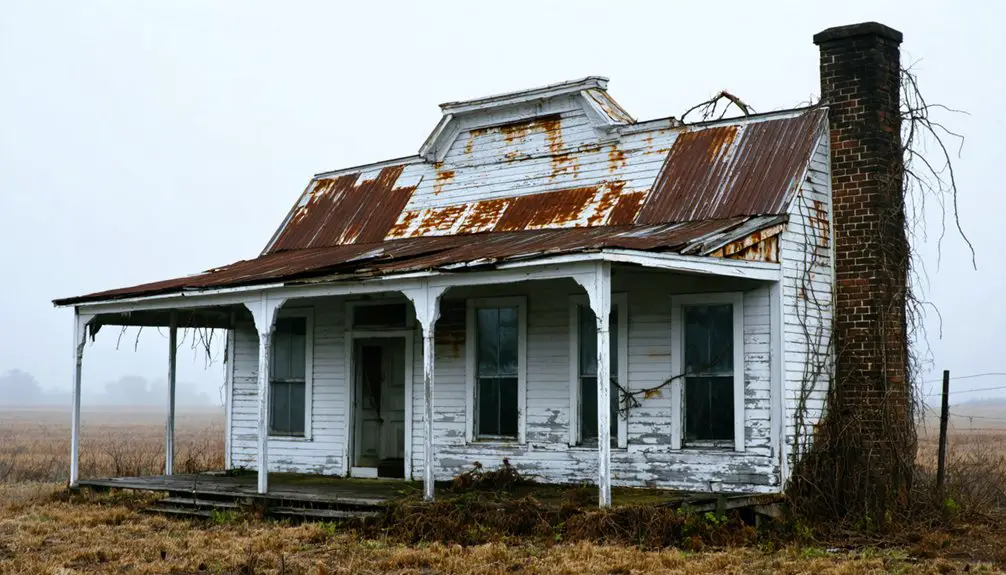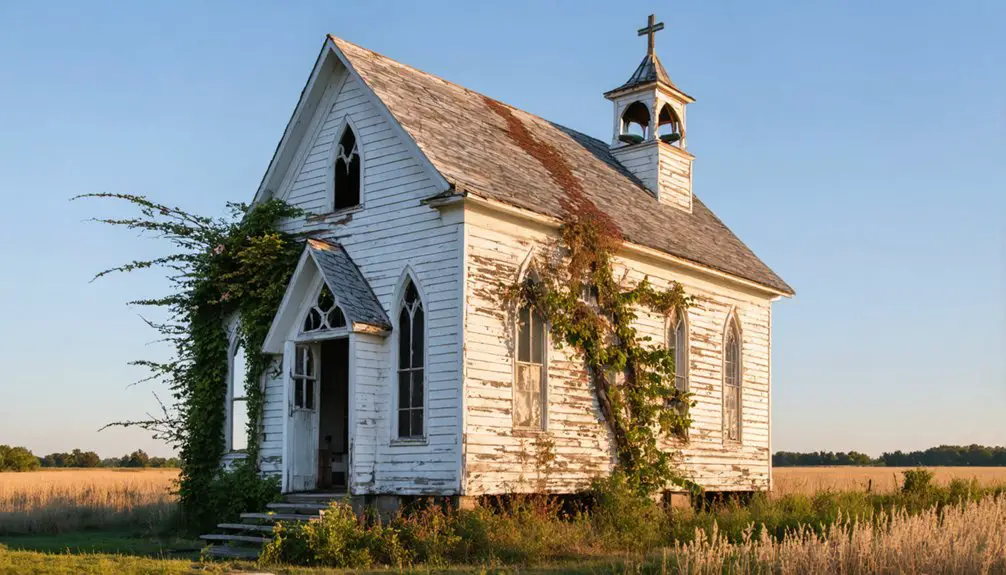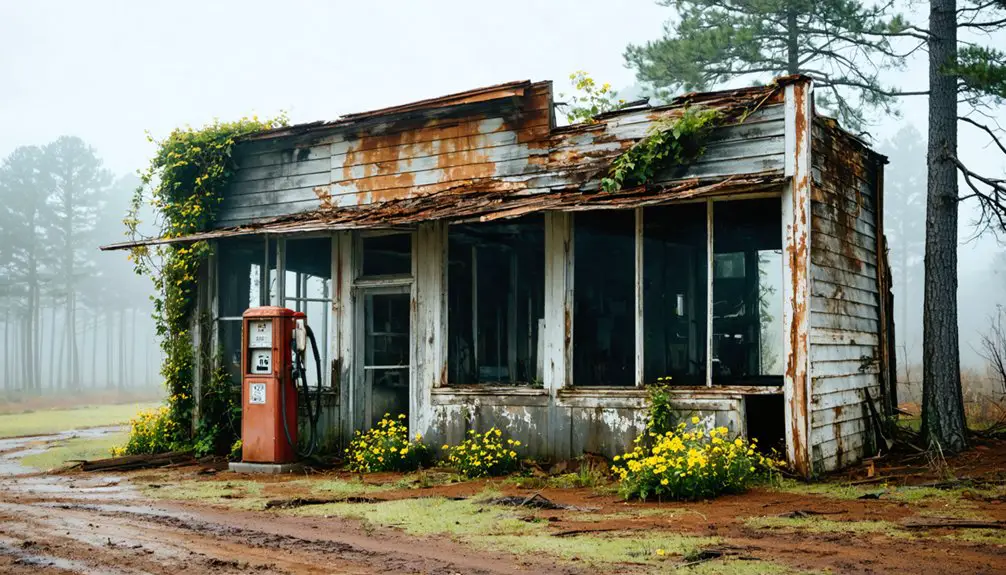You’ll find Hopewell’s ghost town roots in Calhoun County, Mississippi, where it first emerged during the mid-19th century railroad expansion. Originally called Hardin Town, this agricultural community thrived on cotton and corn farming, with a post office established in 1840. The town’s prosperity lasted until 1905 when the post office closed, triggering a series of business failures and population decline. Today, Camp Hopewell and archaeological discoveries reveal fascinating layers of this vanished community’s story.
Key Takeaways
- Hopewell, originally known as Hardin Town, was established in Calhoun County during the mid-19th century railroad expansion period.
- The town’s post office closure in 1905 marked a critical turning point in its decline toward ghost town status.
- Economic decline accelerated when major employers closed and transportation routes bypassed the community.
- Young residents left Hopewell for better opportunities elsewhere, leading to population decline and eventual abandonment.
- The historic Hopewell Presbyterian Church, established 1849, operated until 1981 before being transformed into Camp Hopewell.
The Rise of a Southern Community
While railroad expansions swept through Mississippi in the mid-19th century, the small community of Hopewell emerged in Calhoun County as a promising agricultural settlement. Early settlers like W.T. Sandifer, Daniel Young, and Mr. Barron helped establish a strong community identity centered around farming and local commerce.
You’d have found fertile soil supporting cotton and corn cultivation, which quickly became the economic foundation of the area.
As Hopewell grew, you would’ve witnessed the development of essential infrastructure including shops, churches, and schools. The establishment of a post office in 1840 marked a significant milestone, connecting residents to the wider world. The community faced devastating outbreaks of yellow fever epidemics that impacted population growth. Like many place name settlements, Hopewell required clear distinctions from other similarly named locations.
Agricultural practices thrived through the labor of plantation workers, while small businesses emerged to serve the growing population’s daily needs.
Post Office Era: 1840-1905
The establishment of Hopewell’s post office in 1840 marked the beginning of a significant 65-year period in the town’s history.
As an essential community hub, the post office served the agricultural town‘s residents, who relied on postal communication for news, business, and personal correspondence.
You’d have found the post office at the center of daily life, where farmers gathering to collect mail would exchange news about cotton prices and crop conditions.
The facility supported Hopewell’s growth throughout the latter half of the 19th century, operating alongside local shops, a church, and a school.
Life in Early Hopewell
During the early 1840s, pioneering families like the Chruthirds, Sellers, and Phillips established Hopewell’s first settlement along Big Creek, nine miles north of present-day Vardaman, Mississippi.
The Hardings, Campbells, Morgans, and Reids soon followed, contributing to the growing community’s development. The region had a rich history, as archaeological evidence shows trade networks extended from the Great Lakes to the Gulf of Mexico. Originally known as Hardin Town, the settlement was named by Johnnie Hardin in 1845.
Settler lifestyles centered around small villages near waterways, with families living in simple rectangular homes built from wattle and daub with thatched roofs.
You’d find community dynamics shaped by a clear social hierarchy, reflected in their burial practices – leaders and hunters received elaborate burials in geometric earthworks, while common folk were buried separately.
Religious Divisions and Social Change
As religious practices evolved in Hopewell, social hierarchies became increasingly defined through ceremonial rituals and burial customs.
You’ll find evidence of social stratification in the way community leaders and hunters received elaborate burials, while others had simpler ceremonies.
Religious symbolism played a significant role in shaping the community’s transformation: These sacred spaces reflected the three-level cosmos where rituals connected the Above World, Middle World, and Beneath World.
Sacred symbols and ritual practices drove societal change, molding how Hopewell communities defined themselves and interacted with others.
The discovery of stone smoking pipes demonstrates the central role of shamanic practices in their religious ceremonies.
- Big-men emerged as influential leaders through trade networks and religious authority
- Geometric earthworks served as ceremonial gathering spaces for collective rituals
- Exotic materials like copper and mica reinforced elite status through ceremonial objects
- Shared religious motifs united communities across hundreds of miles
These changes reflected a shift from individual to communal identity, as ceremonial centers became focal points for social integration and cultural exchange throughout the region.
Economic Foundations and Challenges
While Hopewell’s initial prosperity rested on small-scale farming of cotton and corn, its economic landscape dramatically shifted with the arrival of industrial developments in the early 20th century.
Jewish merchants established themselves shortly after DuPont’s arrival, becoming integral to the town’s commercial growth.
You’d find the town’s early agricultural dependency supported by fertile soil, small shops, and a post office that facilitated trade from 1840 to 1905.
The arrival of DuPont’s guncotton plant tested Hopewell’s economic resilience. After DuPont’s closure post-WWI, Tubize Corporation’s artificial silk plant briefly revived hopes in 1923.
However, the devastating closure of Tubize-Chatillon in 1934 eliminated 2,600 jobs. While Allied Chemical and Hercules Chemical later established operations, they couldn’t sustain previous growth levels.
The town’s reliance on single large employers, combined with limited infrastructure and declining connectivity, ultimately contributed to its ghost town status.
The Path to Abandonment
Hopewell’s path toward abandonment began with a series of interconnected setbacks in the early 1900s. Transportation shifts left the town isolated as railroads and highways bypassed the community, severing crucial commerce routes. This economic isolation triggered a cascade of closures, with the post office’s shutdown in 1905 marking a critical turning point.
Consider these defining factors that sealed Hopewell’s fate:
- Loss of transportation access forced businesses to relocate or close
- Young residents migrated to areas with better opportunities
- Lack of industrial development prevented economic recovery
- Regional challenges like post-Civil War hardships compounded local struggles
Without sustainable commerce or indispensable services, Hopewell’s remaining population gradually dwindled. The town’s inability to adapt to changing transportation patterns and establish a strong economic foundation ultimately led to its complete abandonment. The Hopewell Presbyterian Church remained as one of the few standing structures, built in 1849 as a testament to the town’s former vitality.
Legacy of Camp Hopewell
Despite the original town’s decline, Camp Hopewell emerged in 1949 as a transformative presence in the area, beginning with just 10 acres and two modest cabins named McCorkle and Saunders.
From humble beginnings of two cabins on 10 acres, Camp Hopewell rose to become a beacon of transformation.
The trading networks extended from Lake Ontario to Florida, connecting ancient communities through the exchange of goods and ideas. The camp’s spiritual legacy grew from a simple summer program into a year-round ministry within the Holly Springs National Forest, just 5 miles east of Oxford.
You’ll find the historic Hopewell Presbyterian Church, dating to 1849, at the heart of the property. Like the ancient temple mound builders, the site continues to serve as a sacred gathering place for spiritual practices.
After the church’s dissolution in 1981, it became integral to the camp’s identity.
Today, Camp Hopewell stands as an accredited facility where you can unplug from daily life, connect with nature, and engage in faith-based outdoor education.
The camp’s commitment to inclusivity, environmental stewardship, and spiritual growth continues to shape its role as a regional hub for community transformation.
Archaeological Discoveries and Remnants
Through extensive archaeological research, you’ll find remarkable discoveries that illuminate the sophisticated construction techniques of ancient Hopewell builders.
The archaeological significance of this site reveals careful soil selection and layered construction dating back to A.D. 300, evident in the preserved earthworks and burned logs.
The cultural artifacts discovered showcase the site’s rich heritage:
- Intricate burial structures containing copper axes, stone knives, and ceremonial pipes
- Fine craftwork including necklaces, bone carvings, and artistic pendants
- Exotic materials like obsidian from the Rockies and copper from Lake Superior
- Elaborate stone pipes depicting animals, with over 200 found at nearby Mound City
Recent stratigraphic studies have revealed fluctuating occupation patterns rather than continuous settlement, challenging previous assumptions about the site’s historical timeline.
Stories From Former Residents
Through their oral histories, you’ll find that former Hopewell residents gathered regularly at the Presbyterian Church for worship, social events, and community meetings until its closure in 1981.
You can trace how the church served as more than just a spiritual center, hosting important life events from baptisms to funerals throughout its active years.
Your understanding of daily life in Hopewell emerges through stories of residents walking to the post office until 1905, attending church functions, and maintaining agricultural routines that defined this small Mississippi community.
Daily Life Memories
While memories of daily life in Hopewell remain scarce in written records, the town’s agricultural rhythm shaped residents’ experiences from sunrise to sunset. Your daily routines would’ve centered around cotton and corn farming, with cultural practices deeply rooted in Presbyterian church gatherings and community meetings at the post office.
Life in Hopewell meant:
- Starting your day tending to crops in the fertile Mississippi soil
- Trading goods at local shops, where bartering was common practice
- Gathering news and letters at the post office, a crucial hub of information
- Attending church services that reflected both unity and division in the community
You’d find social life revolving around seasonal harvests, church events, and school activities, though racial segregation remained a stark reality of the era.
Community Gathering Places
Former residents’ accounts reveal three primary gathering places that anchored Hopewell’s social life: the Presbyterian Church, local schools, and informal meeting spots.
You’d find the Presbyterian Church at the heart of community events until 1981, hosting everything from religious services to seasonal celebrations. While segregated cemeteries reflected the era’s racial divisions, the church brought both white and Black residents together for worship, though social hierarchies remained evident.
Local schools, often connected to church buildings, served as venues for education and social cohesion through recitals, literacy classes, and agricultural discussions. Camp Hopewell, established in 1951, continued this tradition of bringing people together.
Despite segregation’s constraints, these gathering places fostered storytelling, preserved local history, and maintained essential social networks within the community.
Historical Significance in Mississippi
Since its establishment in the early 1800s, Hopewell played a significant role in Mississippi’s development as a thriving community in Calhoun County.
The town’s cultural heritage and community resilience shine through its Presbyterian church, which served as a cornerstone of local life for generations.
You’ll find Hopewell’s historical significance reflected in these key developments:
- The establishment of a post office in 1840, marking the town’s growth and connectivity
- The church congregation’s 1861 vote to separate southern Presbyterian churches during Civil War tensions
- The integration of freed African Americans as church members after the Civil War
- The transformation of church property into Camp Hopewell in 1951, adapting to changing times
Frequently Asked Questions
What Natural Disasters or Epidemics Contributed to Hopewell’s Decline?
Rising Mississippi waters displaced thousands along the river. You’ll find flood damage reshaped local commerce, while European disease outbreaks decimated native populations, though no specific disaster definitively caused Hopewell’s decline.
Are There Any Documented Paranormal Activities in Abandoned Hopewell Buildings?
You won’t find documented ghost sightings or haunted locations in these buildings – research shows no official paranormal reports, eyewitness accounts, or investigations focusing on supernatural activity in the structures.
What Was the Peak Population of Hopewell During Its Existence?
You’ll find that Hopewell’s peak demographics aren’t precisely documented in historical records, though evidence suggests the population likely remained under 200 residents during its most active years between 1840-1905.
Which Native American Tribes Originally Inhabited the Hopewell Area?
Like ancient footprints in time, you’ll find that Siouan and Algonquian-speaking native tribes shared this cultural landscape, with western regions dominated by Siouan peoples and eastern areas by Algonquian groups.
What Happened to the Town’s Official Records and Documents?
You won’t find most official town records, as they’re likely lost archives from when the post office closed in 1905. Without historical preservation efforts, documents scattered between county offices or vanished entirely.
References
- https://kids.kiddle.co/Hopewell
- https://misspreservation.com/2015/04/21/suzassippis-mississippi-hopewell-presbyterian-church-in-lafayette-county/
- https://mississippifolklife.org/articles/haunted-by-a-ghost-town-the-lure-of-rodney-mississippi
- https://www.themississippimonitor.com/mississippi-has-a-lost-town-most-people-dont-know-about/
- https://wikipedia.nucleos.com/viewer/wikipedia_en_all/A/Hopewell
- https://en.wikipedia.org/wiki/Hopewell
- https://www.esphs.org/wp-content/uploads/2020/08/New-York-Postal-History_The-Post-Offices-and-First-Postmasters-from-1775-to-1980.pdf
- https://www.archives.gov/research/post-offices/locations-1837-1950.html
- https://about.usps.com/who/profile/history/pdf/first-rfd-mississippi.pdf
- https://amazingbibletimeline.com/blog/hopewell-culture-in-upper-mississippi-region/



